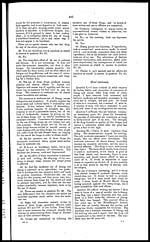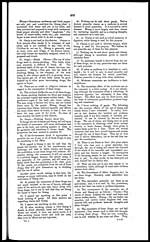Medicine - Drugs > Report of the Indian Hemp Drugs Commission, 1894-1895 > Volume V
(502) Page 482
Download files
Individual page:
Thumbnail gallery: Grid view | List view

482
68. Evidence* of KAURA KHAN, Khan Bahadur, Zaildar, Jatoi, Muzaffargarh
District.
1. As I am a great zamindar of Muzaffargarh
and Dera Ghazi Khan districts, and hemp plant being
cultivated and its produce being used in both the
districts, and especially and zemindars and zaildars
have connection with cultivators and drug contrac-
tors, and with such men who use the drugs, I write
this evidence from my experience. As ganja is
neither produced nor used in this district, my
answer will be with regard to bhang and charas
only.
2. I concur with the opinion expressed in this
question. with regard to the products of the hemp
plant and the different varieties of ganja prepared
from the plant. Although charas is not prepared
in this district, yet I know the way in which it is
prepared. Bhang is known in this district by the
following names:—as bhang, sawee, nimanee, bootee,
sukha, bijya, and sardaee. Charas is known as
charas. In this district the seed of the hemp plant
is called bhang.
3. The hemp plant is cultivated in this district,
and does not grow spontaneously. It grows spon-
taneously in hilly districts, and I do not know in
what district it grows abundantly.
4. The spontaneous growth of the plant is called
kahee bhang, and the different names of the plant
have been noted in answer No. (2).
5. Temperate climate is required for the produc-
tion of this plant, and if there are sufficient rains,
from October to January, the plant grows sponta-
neously. The hemp plant does not grow in the
land containing saltpetre.
6. The growth of the wild hemp plant, dense or
scattered, depends upon the seed. If hard wind
blows, the seeds are scattered, and consequently the
growth is not dense, otherwise the growth is dense.
7. The hemp plant is cultivated for the produc-
tion of—(c) bhang, (d) seeds. The seed is some-
times got from bhang also. In this district the
cultivation of the plant is larger in Alipur tahsil,
but not so large as to meet the demand of the
district. Bhang is imported from Multan and
Dera Ghazi Khan districts. About 100 maunds of
bhang are prepared in this district.
8. I do not know any particulars of increase or
decrease of the cultivation of the hemp plant.
9. If the land is made soft by ploughing it
three or four times and the manure of sheep or
goats is put in the land, the plant grows abundantly,
and if, at the distance of half a foot, four or five
seeds are sown together, the plant grows largely.
The latter way is adopted when tobacco, onions,
brinjals and garlic are sown with it. The seed
of the hemp plant is sown like juwar and
bajra, and the plant grown in sailaba lands is more
intoxicating.
10. Only the agricultural cultivators cultivate
the plant.
11 to 13. I cannot say anything about this.
14. Only bhang is prepared in this district.
The cultivators cultivate the plant according to
their requirements and prepare bhang from it, while
others get it from licensees who bring it from other
districts. About 100 maunds of bhang are pre-
pared in this district.
15. I cannot say anything about this.
Although not prepared in this district, yet it
is used in this district, and the method of the
formation of charas is the same described in ques-
tion No. 2. Charas is not eaten but smoked in
hukas. Hakims prescribe it as medicine.
When the plant is ripe, it is cut and well
dried in the sun.
The above relates to cultivated bhang and not to
the wild plant.
16. The cultivated bhang is prepared in houses
as well as in the fields wherever grown.
I cannot say about the preparation of ganja or
charas.
17. Bhang is prepared by the cultivators. With
regard to charas I do not know.
18. Charas generally deteriorates after throe
years, and loses its effects to a certain extent. It
should be kept in a utensil safe from exposure to
the air. Bhang deteriorates after five years, even
if properly kept. It loses its effects through rain-
fall or if kept in a damp place. It should conse-
quently be well dried, and, as far as possible, be
kept in a dry place.
19. My answers are regarding bhang and charas
only and not with regard to ganja. I know
nothing about ganja. Charas is smoked in hukas,
and hakims prescribe it as medicine, as noted in
question 15.
20. No special classes smoke charas. Low
persons, like kanjars and mirasis, smoke it.
21. Ganja is not used in this district.
22. Desi (native) charas is used in this district,
and is imported from Multan.
23. Bhang is only drunk and not smoked.
24. (a) Well-to-do men take it in halwa (com-
position of flour, sugar, and butter). The propor-
tion of such men cannot exactly be stated, as they
take it in their house.
(b) All sorts of men, whether poor or wealthy,
take bhang, and the number of such men is 20 per
cent. of the population.
25. The use of charas is nearly the same, while
the use of bhang is increasing, for the children of
such men even have begun drinking bhang. Un-
civilized men do not forbid their children to use
it ; in a way, they themselves encourage them.
|
Ganja. |
Bhang. |
Charas. |
|
26. (a) Nil |
. 6 per cent, |
. ¼ per cent. |
|
(b) „ |
. 12 „ |
. ¼ „ |
|
(c) „ |
. 2 „ |
. None. |
|
(d) „ |
. Nil. |
. Nil. |
27. Charas is used by low men, and the frequent
use of the other drugs leads to charas, e.g., the use
of bhang leads to charas and that of liquors to
opium, and the men who smoke the huka ultimately
take to charas-smoking,
Bhang is used by the fakirs and zamindars.
The former use it to remove anxieties, and the
latter to bring sleep and excite hunger.
|
Ganja. |
Charas. |
Bhang. |
|
28. (a) Nil |
.0 2 0 |
0 0 9 |
|
(b) „ |
. 0 4 0 |
0 2 0 |
|
Ganja. |
Charas. |
|
|
29. (a) Nil |
. . . |
Tobacco, |
|
(b) „ |
Tobacco, cardamom and sandal. |
|
* Translation.
Set display mode to: Large image | Zoom image | Transcription
Images and transcriptions on this page, including medium image downloads, may be used under the Creative Commons Attribution 4.0 International Licence unless otherwise stated. ![]()
| India Papers > Medicine - Drugs > Report of the Indian Hemp Drugs Commission, 1894-1895 > Volume V > (502) Page 482 |
|---|
| Permanent URL | https://digital.nls.uk/75122354 |
|---|
| Description | Volume 5: Evidence of witnesses from North-Western Provinces and Oudh and Punjab. Answers from witnesses in North-Western Provinces, Oudh and Punjab about cultivation and growth of hemp, preparation or manufacture, trade, consumption or use, effects, administration - taxation and control. |
|---|---|
| Attribution and copyright: |
|




